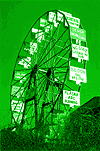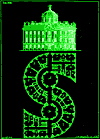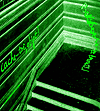Ted
Byfield
Lex Americana
Those
shapes and symbols
I know their meaning
the shameless riches
of another world.
--The Mekons
Since British and American English are nearly orthographically identical, ASCII, the American Standard Code for Information Interchange, might just as well be the Anglophone Standard Code for Information Interchange. But it's not, because as the sun set on the British Empire, it rose--in time, this time, not in space--on the "American Century." But the sun sets on time as well as in space, and this time around it rose on a far more elusive dimension. We could call that dimension "informational," and in a sense it is; but we would do so only at the risk of invoking a landslide of silly commentaries whose primary function has been to assimilate the present to the future rather than to the pasts of which it is in fact composed.[1] However, as time passes, the "informational" is becoming a fact of the past as well as of the present, as real and, therefore, as uncertain as any other historical fact--above all, subject to speculation and interpretation, some of it wildly far afield from the explicit historical considerations and intentions that attended its development. It's fitting that the relentlessly red and white icons of "real" American hegemony--Coke, Marlboro, a baseball, a Campbell's soup can--should give way to "virtual" afterimages, informational afterimages; for, after all, it was America's ephemeral mastery of the informational that largely facilitated the rise of its hegemony. And it's fitting as well that those afterimages, like any other, should be expressed in negative, in colors that complement the thing itself, namely, green and black, the _Urfarben_ of a CRT.
 At
its inception, ASCII was a monolith, the One right Way, an encoding system
that tolerated neither variation nor deviation.[2] From the perspective
of speakers of "other" languages for which ASCII was, by design, technically
inadequate--Francophones who arrogantly insist on diacriticals and Germanophones
who have rigorously systematized exactly how theirs should be parsed,
Hispanophones whose linguistic dominion has dissolved in its own success,
to say nothing of the perverse madness of the Cyrillic world, the recalcitrant
chaos of Semitic languages, the meticulous yet loopy majesty of scripts
derived from Sanskrit, or those inscrutable Asian languages content to
combine ideographs and pictographs--ASCII is a blunderbuss: a crude instrument
of hegemony, an awkward fetish of modernity, a model of impatient _Macht_,
and, above all, an arbitrary artifact of and from another world but no
less real for its alien origins.
At
its inception, ASCII was a monolith, the One right Way, an encoding system
that tolerated neither variation nor deviation.[2] From the perspective
of speakers of "other" languages for which ASCII was, by design, technically
inadequate--Francophones who arrogantly insist on diacriticals and Germanophones
who have rigorously systematized exactly how theirs should be parsed,
Hispanophones whose linguistic dominion has dissolved in its own success,
to say nothing of the perverse madness of the Cyrillic world, the recalcitrant
chaos of Semitic languages, the meticulous yet loopy majesty of scripts
derived from Sanskrit, or those inscrutable Asian languages content to
combine ideographs and pictographs--ASCII is a blunderbuss: a crude instrument
of hegemony, an awkward fetish of modernity, a model of impatient _Macht_,
and, above all, an arbitrary artifact of and from another world but no
less real for its alien origins.
But these are linguistic caricatures that only power can afford, and it can afford them only through the efficient myopia of expropriation. Domination too, to be sure, but expropriation is more to the point, since it hints at the presence of of an exchange--an interchange, to put it more ambiguously, which is to say, less economistically. And indeed, as the Pax Americana stumbles fatally, the industrial base and financial might of the United States begins to dissipate throughout the very networks it constructed--and the instruments of its hegemony take on an explicitly artifactual quality, their sense defined by the cultures that absorb them, their potentials defined and expressed through the cultural structures within which they now function. Thus, the very things that ASCII stands for--America, Standard, Code, Information, and Interchange--have lost their integral, reciprocal cohesion; the origins, forces, and procedures these ideals denote have at the very least become non sequitur if not fallen into direct conflict with each other. And yet the artifact, the character set remains, set adrift from the forces that bore on its prodcution, like the liturgy of long-lost church or an alchemical recipe involving substances derived from species now extinct.
 Small
wonder, then, that ASCII's utility should transmogrify into a curious
combination an all-too-familiar hermenuetic predicament pitted between
rigorous minimality and exuberant excess, that its linguistic literalism
should be transmuted into a figurative freedom, that its transparency
should become opaque, that its infinite flatness should both explode into
a material dimensionality and implode into ephemeral luminosity. Its pixelated
character set of ASCII has itself mutated into a pixel gradient that ranges
from the densest designators of quantitative reason ($, #, and %) to the
terminal lightness of a full stop (.). But where previous pixels were
constructed through the closed, formal mathematics of systematic design,
these new asciimilated pixels embody the synthetic legacy of thousand
of years of orthographic history: Latin majuscules and minuscules, Arabic
numerals, medieval innovations (punctuation) and compensations (y, j),
mathematical symbols and logical operators, typographers' conventions
(&, @) and programmers' connections (|), accents severed from any referent
(~, ^) and elements overloaded with contradictory significations (!),
narrative procedures (delete, linefeed), and, last but not least--indeed,
the first by numerical value--the quintessential ASCII character which,
seen in this light, is not seen at all: the space "character" that merges
with the night. But this museum of historical orthography makes no more
sense by the logic of its intended utility than does a musem collection
that jumbles together religious manuscripts, colonial silverware, and
avant-garde paintings.
Small
wonder, then, that ASCII's utility should transmogrify into a curious
combination an all-too-familiar hermenuetic predicament pitted between
rigorous minimality and exuberant excess, that its linguistic literalism
should be transmuted into a figurative freedom, that its transparency
should become opaque, that its infinite flatness should both explode into
a material dimensionality and implode into ephemeral luminosity. Its pixelated
character set of ASCII has itself mutated into a pixel gradient that ranges
from the densest designators of quantitative reason ($, #, and %) to the
terminal lightness of a full stop (.). But where previous pixels were
constructed through the closed, formal mathematics of systematic design,
these new asciimilated pixels embody the synthetic legacy of thousand
of years of orthographic history: Latin majuscules and minuscules, Arabic
numerals, medieval innovations (punctuation) and compensations (y, j),
mathematical symbols and logical operators, typographers' conventions
(&, @) and programmers' connections (|), accents severed from any referent
(~, ^) and elements overloaded with contradictory significations (!),
narrative procedures (delete, linefeed), and, last but not least--indeed,
the first by numerical value--the quintessential ASCII character which,
seen in this light, is not seen at all: the space "character" that merges
with the night. But this museum of historical orthography makes no more
sense by the logic of its intended utility than does a musem collection
that jumbles together religious manuscripts, colonial silverware, and
avant-garde paintings.  But,
if it's not clear already, to say that is not to claim that it makes no
sense at all. Since the histories that conspired, if inadvertently, to
produce ASCII are for the most part discontinuous, it's fair to ask whether
or in what ways these newer uses of ASCII amount to a significant break
from the past. ASCII art is, of course, as old as if not older than ASCII
itself: witness the figurative literalism of DEC's "Famous Figure 1,"
or the proto-texture-mapped decorative borders of .sigs that stretch back
through bang paths of UUCP networks and into the boot-sequence screens
shown on the earliest terminals. In some senses, the answer to this question
is surely no, as these technocratic yet oddly iconophobic interweaves
and crude grafittis of the digital age, attest; but in other senses, the
answer is surely yes, because the mere fact of a precursor hardly demonstrates
that there is nothing new on the screen. One would be hard pressed to
claim that _Deep Throat_ rendered in streaming ASCII art is a simple derivation
of some seminal .sig or a pinup rendered in percentages on a lineprinter,
or that a surreal "RUSCII" level for the game Unreal--with massive extruded
cyrillic characters adrift in darkened skies, unrecognizable letterforms
lying like shipwrecks in a transparent sea of tildes, and obscene images
of blow jobs even more obscenely arrested, floating cockeyed through space--is
merely an embellishment of a figlet font and assorted other neglected
zombie processes that still malinger in /usr/games. And given the convoluted,
topological, self-referential spectacle of silently punting past a monumental
yet unrecognizable letter texture-mapped with significations both orderly
and disorderly, lying on its side in a calm ocean mutely inflected with
visual puns, it's hard to say at all whether this history will be written
at all, let alone by what invisible hand or in what language. Perhaps
this is the history but we have yet to learn to read it.
But,
if it's not clear already, to say that is not to claim that it makes no
sense at all. Since the histories that conspired, if inadvertently, to
produce ASCII are for the most part discontinuous, it's fair to ask whether
or in what ways these newer uses of ASCII amount to a significant break
from the past. ASCII art is, of course, as old as if not older than ASCII
itself: witness the figurative literalism of DEC's "Famous Figure 1,"
or the proto-texture-mapped decorative borders of .sigs that stretch back
through bang paths of UUCP networks and into the boot-sequence screens
shown on the earliest terminals. In some senses, the answer to this question
is surely no, as these technocratic yet oddly iconophobic interweaves
and crude grafittis of the digital age, attest; but in other senses, the
answer is surely yes, because the mere fact of a precursor hardly demonstrates
that there is nothing new on the screen. One would be hard pressed to
claim that _Deep Throat_ rendered in streaming ASCII art is a simple derivation
of some seminal .sig or a pinup rendered in percentages on a lineprinter,
or that a surreal "RUSCII" level for the game Unreal--with massive extruded
cyrillic characters adrift in darkened skies, unrecognizable letterforms
lying like shipwrecks in a transparent sea of tildes, and obscene images
of blow jobs even more obscenely arrested, floating cockeyed through space--is
merely an embellishment of a figlet font and assorted other neglected
zombie processes that still malinger in /usr/games. And given the convoluted,
topological, self-referential spectacle of silently punting past a monumental
yet unrecognizable letter texture-mapped with significations both orderly
and disorderly, lying on its side in a calm ocean mutely inflected with
visual puns, it's hard to say at all whether this history will be written
at all, let alone by what invisible hand or in what language. Perhaps
this is the history but we have yet to learn to read it.
NOTES
[1] To William Gibson's quip that "The future's already here, it's just
unevenly distributed," one could retort something more to the point: the
past is already here, it's just unevenly distributed.
[2] In fact, ASCII has spawned numerous sub- or para- ASCIIs better suited to the requirements of various non-English languages; however, higher-level protocols (such as the URL standard, which adheres to the Ur-ASCII) have ironically--or maybe it's not ironic at all--affirmed US-ASCII as the common denominator of the ASCII family and thereby entrenched its hegemonic status.